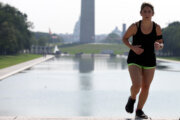Diets that focus on what to eat instead of what to avoid are gaining popularity. The Blue Zones diet is one of those diets. Similarly to the Mediterranean diet, the Blue Zones diet celebrates the eating patterns and lifestyles of specific regions of the world. The focus is on adding foods eaten most often by the longest-lived and happiest populations.
With this diet, years of life are more important than numbers on a scale. Instead of cutting carbs, the diet adds an abundance of quality carbohydrates like whole grains, beans, potatoes and other vegetables. It’s a diet that aims to increase longevity and vitality.
What Are the Blue Zones?
The Blue Zones are regions with the highest concentration of centenarians, or people who have lived for 100 years or more. The concept grew from the research of Dan Buettner, a National Geographic explorer and fellow.
Buettner and his team of scientists identified longevity hotspots in the world and studied the commonalities in these long-lived communities.
These are the five original Blue Zones:
— Okinawa, Japan: An island off the coast of Japan
— Sardinia, Italy: A mountainous part of an Italian island in the Mediterranean
— Ikaria, Greece: A small Greek island in the Aegean Sea
— Nicoya, Costa Rica: A peninsula in eastern Costa Rica
— Loma Linda, California: A vegetarian community of Seventh-day Adventists
The research has been around for 20 years, and Buettner has written several books, including “The Blue Zones Solution.” Yet with the release of the popular Netflix documentary series “Live to 100: Secrets of the Blue Zones,” the Blue Zones way of eating and living has reached a whole new level of fame. There are now even Blue Zones retreats, which allow people to have an immersive health experience at a number of different locations.
Now you can buy Blue Zones Kitchen frozen dinners that are “crafted for longevity,” including a plant-based burrito bowl with sweet potatoes and black beans that is inspired by the cuisine in Nicoya, Costa Rica.
Food products like Bush’s Beans are boasting “Blue Zones-certified” on package labels. Communities in North America are transforming into Blue Zones with the Blue Zones Project. Restaurants, grocery stores, schools and workplaces are also gaining Blue Zones-certified status.
Physicians can even become Blue Zones-certified via a new partnership with the American College of Lifestyle Medicine.
[SEE: Mediterranean Diet vs. Nordic Diet.]
Blue Zones Diet vs. Mediterranean Diet
The Blue Zones diet has many similarities to the Mediterranean diet. In fact, two of the Blue Zone regions are in the Mediterranean: Ikaria and Sardinia. Researchers believe the Greek Island of Ikaria has the greatest adherence to the Mediterranean diet in the world, and people there live on average about seven years longer than Americans. The Mediterranean island of Sardinia, the first Blue Zone region identified, has nearly 10 times as many centenarians per capita than the U.S.
However, the Blue Zones include regions beyond the Mediterranean and the components of the diet are more diverse. For instance, residents in Okinawa, Japan eat more soybeans, primarily as tofu. While some of the foods may differ, the eating patterns in all of the regions are largely based on plants.
Like the Mediterranean diet, moderate alcohol consumption is a part of the Blue Zones diet (except in Loma Linda). People might have one to three small glasses of red wine per day, often during a meal and with family or friends. Olive oil is also the primary cooking oil in most Blue Zones and is used to top salads and vegetables.
[READ What Makes a Healthy Olive Oil?]
Health Benefits of the Blue Zones Diet
People in the Blue Zones live longer than Americans and have among the world’s lowest rates of heart disease, certain cancers, diabetes, dementia and obesity.
“These diets are rich in fiber, vitamins, minerals, healthy fats and phyochemicals, which help reduce inflammation, oxidative stress, cholesterol levels, blood pressure levels and promote healthier weight levels,” says Sharon Palmer, one of U.S. News & World Report’s Best Diets expert panelists. Palmer is known as the Plant-Powered Dietitian, has visited all five Blue Zones and studied nutrition at Loma Linda University, which is located in the only original Blue Zone in the United States.
People living in Blue Zones also tend not to overeat, which Palmer notes leads to less obesity. Okinawans follow what’s referred to as the 80% rule or “hara hachi bu,” which stems from a Confucian-inspired mantra that’s spoken before meals to remind people to stop eating when their stomachs are 80% full.
Beyond food, the Blue Zones share specific lifestyle habits that are believed to contribute to their longevity. Buettner calls these habits and eating patterns the Power 9:
— Move naturally: Build activity into your day.
— Purpose: Know why to wake up in the morning.
— Down shift: Reduce your stress.
— 80% rule: Stop eating when you’re 80% full.
— Plant slant: Eat primarily plants.
— Wine at 5: Enjoy moderate amounts of wine.
— Right tribe: Seek social circles to support healthy behaviors.
— Loved ones first: Maintain close family relationships.
— Belong: Join a faith-based community.
Social encouragement, or having what Buettner calls the “right tribe,” is a vital lifestyle habit. Blue Zones centenarians, also referred to as “super-agers,” live in social networks that promote healthy behaviors that make it easier to stick to a healthy lifestyle.
Buettner says we put too much emphasis on miracle diets, supplements, superfoods and gym memberships and completely overlook the social side of health, such as quality relationships with family and friends. Rather than trying to prevent death, he says it’s about learning how to truly live.
“While the Blue Zones diet and lifestyle sound idyllic, most of us don’t have the privilege of being able to integrate these longevity guidelines fully into our lives,” says Canadian registered dietitian and writer Abby Langer.
Langer lists the cost of living and healthcare, a busy work life and cold climates that make growing our own food year-round virtually impossible as examples of barriers to living a Blue Zone lifestyle.
There are things a Blue Zone Diet can’t address, such as access to healthcare, stress levels, living conditions, economic situation, geographical location and genetics, according to Langer. Even so, she recommends adopting some of the Blue Zone diet concepts such as eating plenty of plants, less meat and limiting alcohol.
“When it comes to Blue Zones, focus on what’s realistic for you and your life,” she says.
What to Eat on the Blue Zones Diet
About 95% of the diet is plant-based, and 65% of calories come from carbohydrates, predominantly pulses, starchy tubers and whole grains.
Foods regularly eaten in Blue Zones include:
— Pulses: Beans, peas and lentils are some of the top longevity foods eaten in all of the Blue Zones, including fava, black beans, garbanzo, soybeans and white beans. At least ½ cup of pulses are eaten daily.
— Tubers: Sweet potatoes, purple potatoes and regular potatoes are dominant in the diet.
— Whole grains: Grains are frequently eaten, including bulgur, farro, oats, barley and ground corn. Not all the grains are whole. In Okinawa, white rice is common, and in Sardinia, they frequently eat sourdough bread and white pasta.
— Leafy greens: Local, seasonal plants are eaten daily, including a high frequency of leafy greens, such as dandelion greens, turnip and fennel tops, kale, chard, collards and wild varieties of spinach.
— Nuts: One or two handfuls of nuts are eaten daily, primarily almonds, walnuts, pistachios, cashews and pine nuts.
These foods are also included in the Blue Zones Diet, but they’re eaten less frequently:
— Beef, pork and chicken: While only the Seventh-day Adventists in Loma Linda, California, totally avoid meat, residents in other regions eat meat occasionally, maybe five times a month. Meat is more likely to be considered a celebratory food and is eaten as a small side or a way to flavor dishes.
— Seafood: Fish is eaten up to three times weekly. Care is taken to not overfish in local waters.
— Dairy: Goat and sheep’s milk is more common than cow’s milk. Fermented yogurt and cheese are primarily eaten, including feta and pecorino cheese.
— Eggs: People in the Blue Zones eat eggs about two to four times a week, and often outside of breakfast.
What Not to Eat on the Blue Zones Diet
Residents of the Blue Zones rely on fresh, whole foods and their diets do not contain the packaged, processed foods that are common in U.S. diets. The foods limited on the Blue Zones diet include:
— Sugar-sweetened beverages: Water is the primary beverage of choice, along with coffee, tea and red wine in moderation.
— Packaged sweets: Fruit is typically eaten for dessert.
— Salty snacks: Instead of chips, people in the Blue Zones snack on nuts.
Blue Zones Recipes
Pulses and sweet potatoes are frequently eaten in the Blue Zones. Here are two Blue Zones recipes using these longevity foods.
Sesame soy glazed roasted Japanese sweet potatoes
Japanese sweet potatoes have a deep magenta skin and pale yellow flesh that turns gold as it cooks. They’re creamier and drier than orange-fleshed sweet potatoes, which makes them ideal for roasting. This Okinawa-inspired recipe is courtesy of Sharon Palmer.
Ingredients:
— 1 ½ pounds Japanese sweet potatoes
— 2 tablespoons soy sauce
— 1 ½ tablespoons sesame oil
— 1 tablespoon pure maple syrup (optional)
— ½ teaspoon garlic powder
— ¼ teaspoon red chili flakes
Toppings:
— 1 tablespoon sesame seeds (black or beige)
— 2 tablespoons sliced chives or green onions
Instructions:
1. Preheat oven to 375 degrees F.
2. Wash and peel sweet potatoes. Slice into thin wedges.
3. Arrange sweet potato wedges in a 9 x 13-inch baking dish.
4. In a small bowl, mix together soy sauce, sesame oil, maple syrup (optional), garlic powder and red chili flakes.
5. Drizzle the sesame soy glaze over the sweet potato wedges and toss with tongs to distribute well.
6. Sprinkle with sesame seeds and place in the oven. Bake at 375 degrees F for 35 to 40 minutes, until tender and golden brown.
7. Remove from oven, sprinkle with sliced chives or green onions, and serve.
Baked Ikaria chickpeas
Ikarians eat a variation of the Mediterranean diet that’s abundant in beans, whole grains, potatoes, greens and olive oil. This easy chickpea recipe is courtesy of Blue Zones.
Ingredients:
— 1 pound dried chickpeas
— 1 zucchini cut into ½ inch cubes
— 2 carrots cut into ½ inch cubes
— 1 small onion cut into ½ inch cubes
— Mint leaves (dried or fresh)
— Olive oil
Directions:
1. Soak chickpeas.
2. With fresh water, bring peas to a boil for five minutes.
3. Drain off water and rinse chickpeas with fresh water, and bring back to a boil. Cook until almost done so that they are firm, not hard.
4. Mix vegetables together with mint and toss liberally with olive oil. Then spread out in the bottom of a large baking pan.
5. Add cooked chickpeas on top and about a ¼ inch of chickpea water to vegetables.
6. Bake in a preheated over at 350 degrees F for about 15 minutes or until vegetables and chickpeas are tender and slightly browned.
7. Toss, and add salt and pepper to taste.
More from U.S. News
Best Products for Summer Health Hazards
Best Foods to Eat for Gut Health
The Blue Zones Diet: Benefits, What to Eat and Recipes originally appeared on usnews.com







